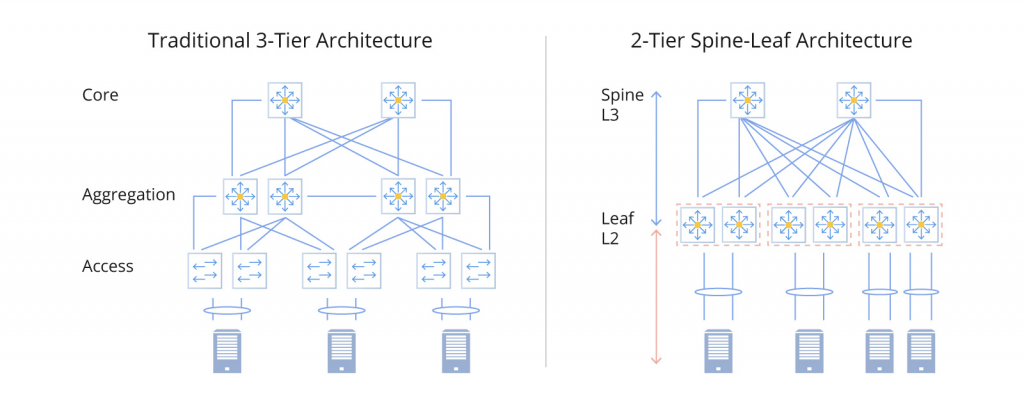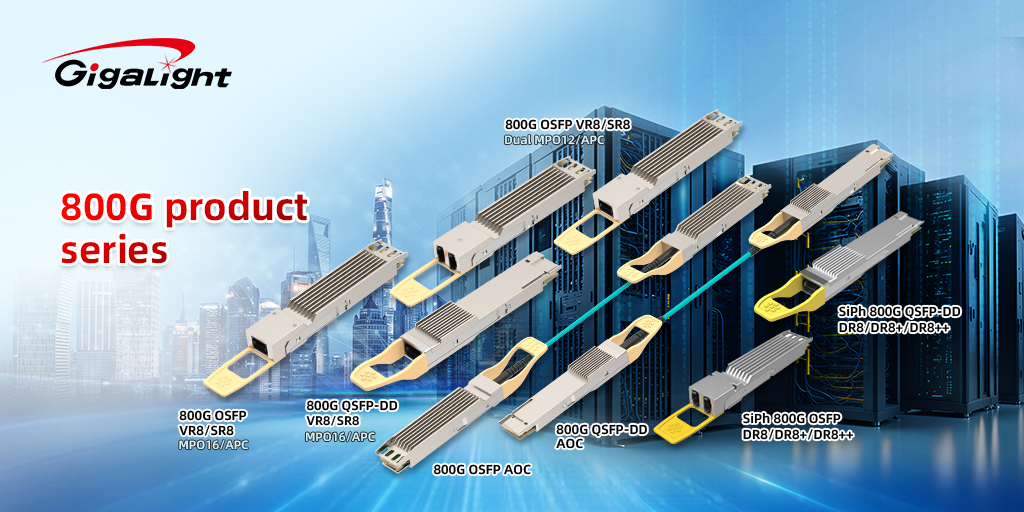The surge in demand for 800G optical transceivers directly reflects the increasing demand for artificial intelligence-driven applications. As the digital environment continues to evolve, the need for faster and more efficient data transmission becomes imperative. The deployment of 800G optical transceivers, coupled with the transition to a tier 2 leaf-spine architecture, reflects a strategic move to meet the needs of modern computing.
Why do we need 800G optical transceivers?
The surge in demand for 800G optical transceivers is closely related to changes in data center network architecture. The traditional three-tier architecture (including access tier, aggregation tier and core tier) has been the standard for many years. As the scale of AI technology and east-west traffic continue to expand, data center network architecture is also constantly evolving. In the traditional three-tier topology, data exchange between servers needs to go through access switches, aggregation switches and core switches, which puts huge pressure on aggregation switches and core switches.
If the server cluster scale continues to expand according to the traditional three-tier topology, high-performance equipment will need to be deployed at the core tier and aggregation tier, resulting in a significant increase in equipment costs. This is where the new Spine-Leaf topology comes into play, flattening the traditional three-tier topology into a two-tier architecture. The adoption of 800G optical transceivers has promoted the emergence of Spine-Leaf network architecture, which has many advantages such as high bandwidth utilization, excellent scalability, predictable network delay, and enhanced security.

In this architecture, leaf switches serve as access switches in the traditional three-tier architecture and are directly connected to servers. Spine switches act as core switches, but they are directly connected to Leaf switches, and each Spine switch needs to be connected to all Leaf switches.
The number of downlink ports on a Leaf switch determines the number of Leaf switches, and the number of uplink ports on a Leaf switch determines the number of Spine switches. Together, they determine the scale of the Spine-Leaf network.
The Leaf-Spine architecture significantly improves the efficiency of data transmission between servers. When the number of servers needs to be expanded, the scalability of the data center can be enhanced by simply increasing the number of Spine switches. The only drawback is that the Spine-Leaf architecture requires a large number of ports compared to the traditional three-tire topology. Therefore, servers and switches require more optical transceivers for fiber optic communications, stimulating the demand for 800G optical transceivers.
Introduction to GIGALIGHT 800G optical transceivers
In response to the surge in demand for 800G optical transceivers, Gigalight has successively launched short-distance 800G VR8/SR8 optical transceivers/AOCs based on VCSEL lasers and 800G DR8/DR8+/DR8++ optical transceivers based on silicon photonic technology. Gigalight’s silicon optical transceivers and multi-mode VCSEL optical transceivers constitute a complete interconnection solution for high-speed AI data centers.

The multi-mode series 800G VR8/SR8/AOC is equipped with high-performance 112Gbps VCSEL laser and 7nm DSP. The electrical host interface is 112Gbps PAM4 signal per channel and supports CMIS version 4.0 protocol. Using QSFP-DD, OSFP form factor, VR8 supports 30 meters (OM3 MMF) and 50 meters (OM4 MMF) transmission distance; SR8 supports 60 meters (OM3 MMF) and 100 meters (OM4 MMF) transmission distance, with MPO16 and 2×MPO12 Two interfaces are available, suitable for short-distance data center application scenarios.
Silicon optical transceivers focus on solving interconnection scenarios with links exceeding 100 meters. Gigalight silicon optical 800G DR8 supports QSFP-DD and OSFP two form factors. The DR8 transmission distance is 500m, DR8+ can transmit 2km, and DR8++ can transmit 10km. The transceivers uses four 1310nm CW lasers; the maximum power consumption is less than 18W. The currently released version supports two connector architectures: MPO16/APC and Dual MPO12/APC. Compared with the 800G optical transceiver of the conventional 8-channel EML solution, the silicon optical transceiver can use fewer lasers. For example, 800G DR8 can use one laser to achieve lower power consumption. This year, Gigalight will also launch 800G QSFP-DD PSM DWDM8 and 800G OSFP/QSFP-DD 2×FR4 optical transceivers based on silicon photonics, providing customers with more choices.
The adoption of 800G optical transceivers not only solves current challenges, but also provides forward-looking solutions to accommodate the expected growth in data processing and transmission. As technology advances, the synergy between artificial intelligence computing and high-speed optical communications will play a key role in shaping the future of information technology infrastructure.
